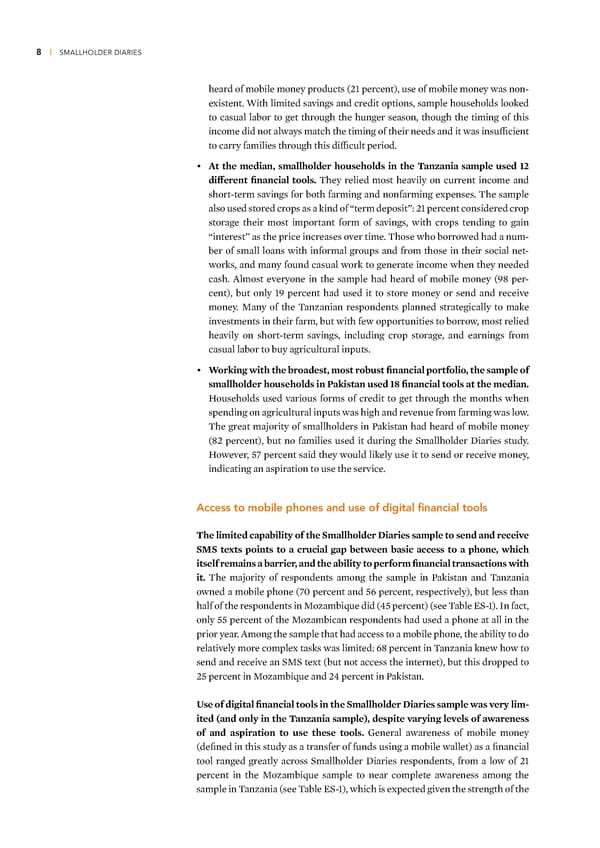8 | SMALLHOLDER DIARIES heard of mobile money products (‘… percent), use of mobile money was non- existent ™ith limited savings and credit options, sample households looed to casual labor to get through the hunger season, though the timing of this income did not always match the timing of their needs and it was insufficient to carry families through this difficult period • „t the median, smallholder households in the anania sample used ŒŽ different financial tools Œhey relied most heavily on current income and short-term savings for both farming and nonfarming expenses Œhe sample also used stored crops as a ind of “term deposit” ‘… percent considered crop storage their most important form of savings, with crops tending to gain “interest” as the price increases over time Œhose who borrowed had a num- ber of small loans with informal groups and from those in their social net- wors, and many found casual wor to generate income when they needed cash ˆlmost everyone in the sample had heard of mobile money (ž¡ per- cent), but only …ž percent had used it to store money or send and receive money –any of the Œan—anian respondents planned strategically to mae investments in their farm, but with few opportunities to borrow, most relied heavily on short-term savings, including crop storage, and earnings from casual labor to buy agricultural inputs • ‘orƒing with the broadest, most robust financial portfolio, the sample of smallholder households in ‚aƒistan used Œ’ financial tools at the median Households used various forms of credit to get through the months when spending on agricultural inputs was high and revenue from farming was low Œhe great ma„ority of smallholders in aistan had heard of mobile money (¡‘ percent), but no families used it during the Smallholder ‰iaries study However, ”• percent said they would liely use it to send or receive money, indicating an aspiration to use the service Access to mobile phones and use of digital financial tools he limited capability of the Smallholder Diaries sample to send and receie SS te‡ts points to a crucial gap between basic access to a phone, which itself remains a barrier, and the ability to perform financial transactions with it Œhe ma„ority of respondents among the sample in aistan and Œan—ania owned a mobile phone (•’ percent and ”¢ percent, respectively), but less than half of the respondents in –o—ambiue did (“” percent) (see Œable œS-…) €n fact, only ”” percent of the –o—ambican respondents had used a phone at all in the prior year ˆmong the sample that had access to a mobile phone, the ability to do relatively more complex tass was limited ¢¡ percent in Œan—ania new how to send and receive an S–S text (but not access the internet), but this dropped to ‘” percent in –o—ambiue and ‘“ percent in aistan “se of digital financial tools in the Smallholder Diaries sample was ery lim- ited (and only in the anania sample), despite arying leels of awareness of and aspiration to use these tools ‡eneral awareness of mobile money (defined in this study as a transfer of funds using a mobile wallet) as a financial tool ranged greatly across Smallholder ‰iaries respondents, from a low of ‘… percent in the –o—ambiue sample to near complete awareness among the sample in Œan—ania (see Œable œS-…), which is expected given the strength of the
 Financial Diaries with Smallholder Families Page 17 Page 19
Financial Diaries with Smallholder Families Page 17 Page 19